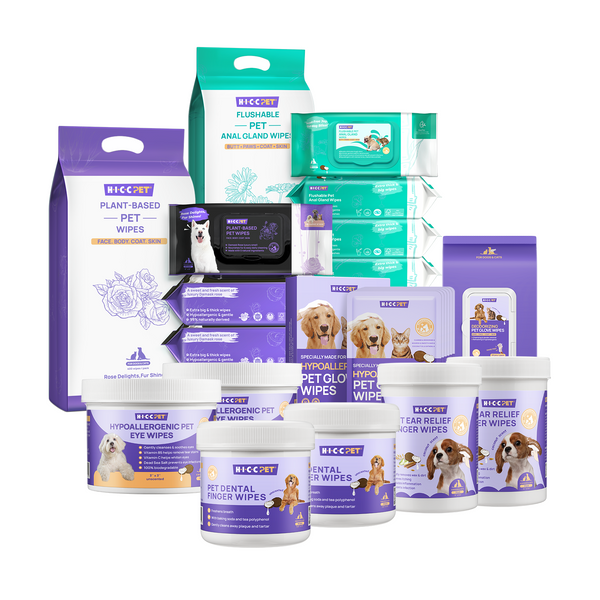The connections we develop with our pets over the years create an unparalleled bond, often making them the missing piece that completes our hearts. Whether you've had your dog since they were a puppy or they entered your life as an adult, one life stage remains a constant challenge as we journey alongside them: the senior years. As their faces gradually gray and their eyes grow cloudy, as leisurely strolls become shorter, and their energy wanes, it becomes our responsibility to ensure their comfort. By continuing to read, we will explore how to provide the best care for your senior dog as they transition into their golden years. It's important to note that the timeline of a dog's life can vary significantly between breeds and sizes. For instance, a Great Dane may enter their senior years as early as 7 or 8, whereas smaller dogs might not reach this stage until they are around 9 to 10 years old. Keep reading to learn how to provide the best care for your senior dog.
Recognizing the Signs of Aging

We all reach that moment when our dogs gradually transition into their senior years. Joints become stiffer, eyes grow cloudier, and their memory begins to fade. The initial appearance of gray hairs around their snout can evoke a mix of emotions in us as dog owners, as it signifies the end of their youthful days. Being able to recognize the physical and mental changes in your aging pup is crucial for ensuring you can provide the necessary care they require. It's important to keep in mind that some dogs may start graying but not slow down, as they might experience these changes early on. Others may remain active until their last year. Nonetheless, identifying the signs of aging equips you to offer the best possible care for your senior dog.
Physical Changes
The physical changes are often more noticeable at first compared to the mental and behavioral changes. Many signs often replicate those of aging in humans as well. The crucial signs to look out for are:
-
Difficulty moving around and moving slower: Overall, as dogs age into their senior years, you may notice that they have more difficulty getting around like they used to. How this looks to you can vary on your dog's usual movement. If unsure, ask yourself a few questions based on your dog’s usual behavior. “Can they no longer jump on a couch to snuggle?”, “Do I need to lift them into the car?”, “Have they started trotting during fetch instead of sprinting across the yard after their ball?”
-
Cloudy eyes or trouble with sight: A common consequence of dogs aging including trouble or loss of sight due to a myriad of conditions. Some common conditions include cataracts, glaucoma, and macular degeneration. Dogs suffering from vision loss will show quite obvious signs such as bumping into walls, trouble locating furniture, toys, etc, no longer making eye contact with you, showing signs of anxiety, or even showing aggression as they start to feel more vulnerable. Luckily for them, dogs do not rely on sight as their main sense and are quick to adapt to change. But eye conditions should still be evaluated by a veterinarian as many can also cause pain that needs to be addressed.
-
Bad breath: Your dog just gave you a huge kiss and you’re thinking “OOF! What is that smell??” Older dogs can often suffer from dental disease, oral infections, or tooth decay. This can be even worse in small dogs like senior chihuahuas who you may often see having their tongue hanging out of the side of their mouth. As dogs age and they weaken, so does their immune system as it struggles to fight off infections as well as it once did. Your vet may recommend regularly scheduled dental cleanings for the heavy lifting but you can maintain your dog’s dental health easily at home between cleanings. HICC Pet™ Dog Dental Finger Wipes and Dental Spray are two simple additions to your dental routine that help save your dog’s teeth and gums down the line.
-
Changes in appetite and weight: A common sign of a dog aging into their senior years is changes in their appetite and weight. It can be very common for senior dogs to have a decrease in appetite for a variety of reasons such as not burning as much energy and their sense of smell and taste decreases. This can then lead to weight loss over time if there are no changes made to their diets. Their weight can also decrease due to a digestive illness or poor absorption of nutrients. Consult your vet immediately if you notice your dog losing about 10% or more of their body weight within a few months.
-
New lumps and bumps on their body: Lumps and bumps often show as dogs may develop fatty limpomas under the skin. Regardless, these bumps can possibly be a malignant tumor and you should have a biopsy done by your veterinarian. Your veterinarian may be able to remove any of these lumps if they are affecting the quality of life of your dog such as making it uncomfortable to sleep properly.
-
Changes in energy levels: As with humans, dogs’ energy levels can drastically decrease as they enter their senior years. They start feeling tired more often as well as not feeling well at all due to other conditions they may be experiencing.
-
Hearing loss: It may start out as seeming like your dog is just ignoring you or having selective hearing. But then, you realize it’s becoming worse and worse until you can no longer gain their attention unless you are right in front of them. Hearing loss, just like vision loss, is a common ailment for senior dogs but also like vision loss, they are able to adapt quickly due to the use of their other senses as well as relying on floor vibrations.
-
Trouble getting around: As dogs age, they are more likely to develop joint problems and pain. This may be more noticeable first thing in the morning or after they’ve been sleeping for a while and may get worse in cold weather. Keeping weight under control as well as providing joint pain medications can help bring some relief to your old pup. You can also add supplements to their diet such as glucosamine, add steps or a ramp to certain surfaces like the couch or bed, and ensure a certain amount of scheduled daily exercise without overdoing it. If your dog is experiencing this, it’s imperative to be checked by a vet to ensure that this already chronic condition isn’t a sign of an even worse condition like Hemivertebra.
-
Incontinence: To get things straight, incontinence, which is the inability to fully control the bladder, is NOT normal in senior dogs despite the general consensus saying so. It happens to be more common in female dogs. Dogs don’t even know they’re doing it so please don’t scold them. When you bring your dog to the vet for incontinence, your vet may check for a variety of conditions including but not limited to thyroid disease, bladder stones, arthritis, spinal conditions, estrogen deficiency in female dogs, and prostate issues in male dogs. In the meantime, you can pop your pup into a dog diaper or belly band to prevent further leakage around your home.
-
Gray hair and coat changes: As mentioned, aging dogs can often start going gray around their muzzles and eventually most of their face. Unlike some other signs of aging, this isn’t anything of concern and should be taken with grace and embraced.
Mental and Behavioral Changes
As dogs age and their behavior changes, it’s often assumed that this is the result of senility which is called canine cognitive dysfunction syndrome (CDS), or canine dementia but there are often a variety of possible reasons for this change in behavior. Causes of behavioral changes in senior dogs can be the result of pain brought on by conditions such as arthritis as well as a neurologic disease, cancer, metabolic disease, endocrine disease, or immune-mediated disease. This may even be the result of anxiety due to changes in their body due to one of the conditions formally listed or environmental and routine changes, especially as senior dogs are often set in their ways. Be sure to check for signs of a physical condition before writing off your dog’s behavioral issues as senility. Smaller dogs are more often the victim of cognitive decline due to them living longer. Veterinarians use the acronym DISHA as a way to classify different types of behavioral changes as they relate to cognitive function. DISHA stands for:
- Disorientation: Disorientation can be seen as not recognizing people they know, getting lost, wandering, and getting stuck behind doors and furniture.
- Sleep cycle changes: Dogs are considered to be going through sleep cycle changes when there is increased daytime sleeping while being restless and pacing at night.
- Housesoiling, learning, and memory: This can be seen as having accidents and urinating indoors as soon as coming inside from outdoors. Senior dogs suffering cognitive decline may also stop responding to their training and react negatively to changes in their life.
- Activity changes: When dogs are showing signs of reduced interest in play, unable to settle, pacing or wandering, and doing repetitive behaviors such as non-stop licking or biting of a certain area on their body, this can be a sign of cognitive decline.
Other behavioral changes that vets watch for in senior dogs are:
-
Anxiety: Dogs may develop new fears and anxiety over both parts of their life that have not changed as well as a higher risk of developing anxiety over new people, places, and situations.
- Learning, and memory loss: Senior dogs suffering cognitive decline may also stop responding to their training and react negatively to changes in their lives.
Lifestyle Changes

As dogs age, there are multiple considerations to take in regard to lifestyle changes in order to make your dog more comfortable as well as prevent or manage chronic illnesses and pain.
Diet
A key part of working to prevent chronic illnesses in senior dogs is avoiding obesity. This can onset fairly easily as your senior dog slows down as they aren’t exhibiting as much energy as their younger counterparts. Obesity is not only a huge contributor to osteoarthritis and other health conditions but it can contribute to a shortened life span. Senior dogs who are overweight or inactive should be switched to a weight control or low-calorie diet with an increased nutrient-to-calorie ratio. In general, senior dogs should be fed a diet that:
- Has a minimum of 25% protein from a good quality protein source
- Is complete and balanced in nutrition
- Includes increased hydration
- Includes omega-3 fish oil to help reduce joint inflammation.
Managing Chronic Illnesses
Being the one responsible for managing your senior dog’s chronic illness during their geriatric years may seem scary but we’re here to help give an insight as to what they may look like. While we never want our dogs to develop a chronic illness, we should always be prepared for it as we are their guardians and they rely on us to give them the best are possible. The key to preventing becoming overwhelmed or feeling like everything is falling apart is to get ahead of it before that happens. And YES, that is possible.
For dogs on multiple medications, It’s recommended to create a calendar that includes the daily medications with what times they should be given as well as the ability to mark off when each one has been given. Phone reminders can create the ability to be on time with dosages and this can be done on a weekly basis to make it not so overwhelming. A pill organizer can make the process of giving daily medications much simpler as you aren’t going through each bottle every day ensuring that you’re giving the proper dosage each time.
We also recommend keeping a notebook on hand regarding your senior pet’s needs. This can include sections such as personal information, medication information, lab work as well as veterinarian notes section which can include noting anything that needs to be brought up at your next appointment.
Exercise and Movement
Just because senior dogs would often rather lay in bed all day taking naps than go for long walks, it is still up to us, their parents, to make an effort to ensure that they are still getting some form of daily exercise. This not only helps with weight management but also helps in preventing and managing joint-related chronic illnesses such as osteoarthritis. When it comes to exercise and pain relief from doing so, your veterinarian may recommend:
-
Physical Therapy: This may include hydrotherapy, laser therapy, shockwave therapy, acupuncture, and/or massage therapy.
-
Pain Medications: Nonsteroidal anti-inflammatory drugs (NSAIDs) are a common medication given to provide relief for pain in dogs such as Meloxicam. Other common medications include the off-label use of Gabapentin for nerve pain.
-
Joint Supplements: Adding daily supplements to your pet’s daily diet can make a drastic difference in your dog’s health. Common supplements for senior dogs include glucosamine, omega-3 fish oil, green-lipped muscle Vitamins C and E, manganese, or hyaluronic acid to aid in the prevention and relief of arthritis and cartilage loss.
-
Adequan Injections: A veterinarian may recommend these injections to slow down or even reverse the effects of cartilage loss.
-
At-Home Therapy: There are also ways you can help your dog strengthen their muscles and keep their joints flexible just by doing some simple exercises at home. Your veterinarian or physical therapist may even provide a specific routine to do at home.
-
Assisi Loop: The Assissi Loop is a revolutionary product that helps to decrease pain and inflammation as well as accelerate the healing of soft tissue and bone. This is done by Targeted Pulsed Electromagnetic Field (tPEMF™) therapy which uses electromagnetic waves targeted at specific frequencies to stimulate an animal’s natural healing and recovery process. You can learn more about tPEMF™ therapy from the creators of Assisi Animal Health.
- Don’t Overdo It: It may seem simple but many dogs don’t know their limits and will keep pushing despite being in pain. Stick to shorter walks but increase their enrichment at home or allow them to do some extra sniffing along those walks.
Environmental Adaptations

Creating a Comfortable Living Space
When our body and bones ache, all we want is for everything to be simplified with easier accessibility with as much comfort as possible. Senior pets are the same way except we have to do it for them as some definitely like to push their limits. Ways to create a more comfortable living space for your senior dog:
-
Adequate bedding: Despite age and potential chronic conditions, your senior dog will often still insist on jumping on the couch as it’s the comfiest spot in the house. Adding more pet beds and bedding around the home can hopefully discourage them from doing so as they now have enough options for ultimate comfort.
-
Orthopedic Beds: We all love a good memory foam mattress but so do our dogs! They can make it easier for your aging pup to rise out of bed while being softer on their aching joints. The purpose of orthopedic beds is to support the spine and joints as many senior dogs suffer from some kind of spinal or joint-related condition or pain.
- Keep essentials close: In an effort to keep your senior dog from over-exerting themselves and needing to go all around the house for their essentials, consider keeping everything close by to where they often hang out during the day. For example, keep their food and water bowls in the same room as them as well as their favorite toys. Consider keeping a bowl of water in your bedroom if that’s where they sleep at night so they aren’t having to walk far for a midnight sip of water.
Senior Pet Safety
Keeping your senior dog safe is absolutely essential in providing them the best care possible. As they age, there will be things that become harder for them to do which are also harder on their body. By implementing some of these suggestions into your home-based and your and your senior dog’s needs, you can greatly improve their quality of life.
-
Ramps and Steps: Ramps and steps can be an extremely useful tool to aid in the ability to get up and down from surfaces instead of jumping which they either may not be able to do at all due to pain or shouldn’t be doing. While ramps and stairs are highly recommended for breeds such as dachshunds and corgis who are prone to spinal issues, it’s absolutely non-negotiable that they are used for seniors of this kind of breeds.
-
Hardwood Floors: Hardwood floors can be the all-time nemesis of senior dogs as they struggle to move around their own home. In order to combat this issue, you can place more rugs around the home, primarily in the areas that your dog accesses most often. Another alternative is grips that stick to the bottom of your dog’s paws to create traction.
-
Baby Gates: Dogs who are suffering from vision loss and even decreased cognitive function may find themselves in some sticky situations as they can wander into dangerous places or areas that they can’t get themselves out of. Consider adding baby gates to certain parts of your home if your dog is at risk of this to keep them safe.
-
Indoor Potty Patches: Senior dogs can often have a weaker bladder which can result in more potty time. By having an indoor potty patch indoors, you’re reducing the amount of times they need to be taken out for potty breaks as well as giving them opportunities to relieve themselves overnight without disrupting their sleep.
-
Provide Adequate Lighting: Older dogs may have reduced vision. Ensure your home is well-lit to help them navigate safely, particularly at night so they aren’t going bump in the night.
-
Supervise Interaction with Other Pets: Monitor interactions with other pets, especially if there's a size or energy difference that might lead to accidental injuries. A lot of pet owners bring a puppy into their home as their dog reaches their senior years in the hopes of bringing energy back to their aging dog. While this can absolutely help, playtime should always be supervised so your senior dog isn’t at risk of being hurt.
- Emergency Plan: Senior dogs can come with emergencies. To be better prepared and help your dog as soon as possible, keep a first aid kit in your home as well as have the location of the nearest emergency veterinary hospital.
Mobility Aids And Accessibility Improvements
Mobility support is often recommended for senior dogs in one way or another as they require more assistance for things they used to be able to do so easily such as jumping in the car or going down the stairs. There are a variety of tools available to help both you and your dog make mobility easier for them.
-
Elevated Bowls: Elevating your dog’s bowls can help prevent neck and back problems from getting worse, especially in larger breeds.
- Harnesses, Braces, and Wheelchairs: Just as discussed, older dogs often develop joint and back issues which can really hinder their ability to get around. Support harnesses, braces, and wheelchairs can greatly improve your dog’s quality of life and provide them more freedom. Even if they don’t need it every day or all the time, it can greatly improve their mobility on “bad days”. We recommend Walkin’ Pets for the mobility aids you may need.
Mental and Emotional Well-Being

Mental Stimulation
Mental stimulation is a key part of preventing or slowing down the process of cognitive decline in senior dogs by keeping their minds active. Mental stimulation often involves physical activity as well which can assist in maintaining their overall health. Enrichment activities such as puzzle toys require physical effort. They even help in keeping your dog’s mind sharp overall which can improve their quality of life. For ideas of mental stimulation, visit our blog on How to Improve Your Pet’s Wellness. You can even take your dog on nature walks where you let them just take their time utilizing all of their senses to take in their surroundings which also happens to be mentally stimulating for them as well.
Customizing mental stimulation activities to match your senior dog's physical abilities and personal preferences is crucial. Seeking advice from your veterinarian regarding a suitable mental stimulation regimen, particularly if your dog has specific health concerns, is highly advisable.
Social Interaction and Companionship
By providing your senior dog with scheduled social interaction, you are helping to alleviate the boredom and loneliness that onset in their senior years. This can then lead to increased anxiety and depression. Consider meeting up with other older dogs in the neighborhood for calm “play dates” so your pup can continue socializing with other pets and people if their walk time has been decreased.
End-of-Life Care and Decision Making
Quality of Life
We know this isn’t a topic that anyone wants to ever deal with but unfortunately, as pet parents, it’s an expected part of the journey with your best friend. There will eventually come a time when you start questioning your senior dog’s quality of life and at that point, your veterinarian can sit down with you and give you a straightforward answer regarding that and whether you should start preparing for it. There might be times when you have this question but in the end, changing up your senior dog’s routine, adding in pain medications, etc, can absolutely improve their quality of life for the time being until it gets to the point where nothing else can be done. Your vet can also provide you with recommendations for palliative and hospice care if needed.
Preparing for End-of-Life Decisions
When it comes to preparing for that inevitable time, the Baltimore Humane Society has put together nine questions to consider when planning your pet’s end-of-life care. Your veterinarian will be able to assist you in the process as it can be emotional and hard to think straight. In this process, you’ll be figuring out any further treatments that are available, what are you willing to do in order to keep your pet alive in the case of rapid health decline, your budget for the aforementioned, who will be performing the euthanasia, and where. There are cases when that moment can be prepared for weeks ahead of time such as with those dogs with untreatable cancer and so forth but it can often happen quickly with the need to provide peace for your dog within the next couple of days.
Coping With the Loss of Your Pet
I can personally say that the days that I’ve lost pets have been the most heart wrenching, emotional, and traumatic days of my life that replay in my head years later. There is absolutely no way to make it easy even if your dog is showing great pain to where euthanasia will let them rest in peace and there is also no way to sugarcoat how you will feel. Keep in mind that everyone processes the death of their pets in different ways. Some people may be able to go right to work the next day whereas some people (me) need almost a week away from anybody to help process what just happened.
Pet loss grief groups are often available as well either in person or online. The Association of Pet Loss and Bereavement is a non-profit organization with the specific goal of providing support to those who have lost their pets as well as resources leading up to the dreaded day. They provide help as well with anticipatory grief which is the grief process that happens prior to losing your pet but while leading up to it.
The looming euthanasia appointment is a difficult reality. We all hope for those final moments to be tranquil and devoid of pain, where our dogs find solace, their weary bodies restored, and they joyfully bound over the rainbow bridge to where we know we will see them again one day.
Conclusion
Caring for senior pets is a deeply rewarding yet challenging journey, characterized by a profound bond that time cannot diminish. Whether they've been with us since puppyhood or joined our lives as adults, their senior years bring unique needs. Recognizing the signs of aging, from changes in mobility to shifts in behavior, is essential in providing the best care for your senior dog. It's crucial to differentiate between age-related cognitive decline and other potential causes of behavioral changes, such as pain or chronic illnesses.
Lifestyle adjustments, including dietary modifications and regular exercise, are vital to support their health. Mobility aids and accessibility improvements can make daily activities easier for senior dogs. Mental stimulation and social interaction contribute to their emotional well-being, slowing cognitive decline and reducing loneliness. When the time comes to consider end-of-life care, planning and seeking support from pet loss grief groups can help navigate the difficult decisions. Through this journey, we offer our senior pets the love and care they deserve, cherishing the moments we share and ensuring their peaceful passage over the rainbow bridge.
Please note that the information provided in this article is for educational and informational purposes only. We are not veterinarians, and the content shared here should not be considered professional veterinary advice.
If you have any questions regarding copyrights or the use of materials in this article, please contact us for clarification.







Thanks for your interaction and support.